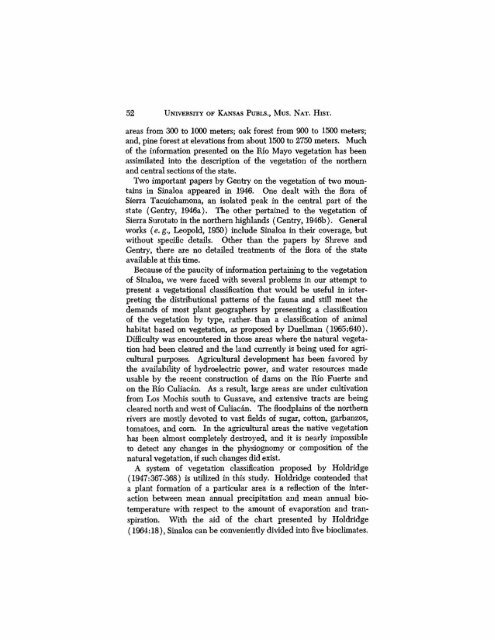The Amphibians and Reptiles of Sinaloa, Mexico - Smithsonian ...
The Amphibians and Reptiles of Sinaloa, Mexico - Smithsonian ...
The Amphibians and Reptiles of Sinaloa, Mexico - Smithsonian ...
Create successful ePaper yourself
Turn your PDF publications into a flip-book with our unique Google optimized e-Paper software.
52 UNIVERSITY OF KANSAS PUBLS., MUS. NAT. HIST.<br />
areas from 300 to 1000 meters; oak forest from 900 to 1500 meters;<br />
<strong>and</strong>, pine forest at elevations from about 1500 to 2750 meters. Much<br />
<strong>of</strong> the information presented on the Rio Mayo vegetation has been<br />
assimilated into the description <strong>of</strong> the vegetation <strong>of</strong> the northern<br />
<strong>and</strong> central sections <strong>of</strong> the state.<br />
Two important papers by Gentry on the vegetation <strong>of</strong> two mountains<br />
in <strong>Sinaloa</strong> appeared in 1946. One dealt with the flora <strong>of</strong><br />
Sierra Tacuichamona, an isolated peak in the central part <strong>of</strong> the<br />
state (Gentry, 1946a). <strong>The</strong> other pertained to the vegetation <strong>of</strong><br />
Sierra Surotato in the northern highl<strong>and</strong>s (Gentry, 1946b). General<br />
works {e. g., Leopold, 1950) include <strong>Sinaloa</strong> in their coverage, but<br />
without specific details. Other than the papers by Shreve <strong>and</strong><br />
Gentry, there are no detailed treatments <strong>of</strong> the flora <strong>of</strong> the state<br />
available at this time.<br />
Because <strong>of</strong> the paucity <strong>of</strong> information pertaining to the vegetation<br />
<strong>of</strong> <strong>Sinaloa</strong>, we were faced with several problems in our attempt to<br />
present a vegetational classification that would be useful in interpreting<br />
the distributional patterns <strong>of</strong> the fauna <strong>and</strong> still meet the<br />
dem<strong>and</strong>s <strong>of</strong> most plant geographers by presenting a classification<br />
<strong>of</strong> the vegetation by type, rather than a classification <strong>of</strong> animal<br />
habitat based on vegetation, as proposed by Duellman (1965:640).<br />
Difficulty was encountered in those areas where the natural vegetation<br />
had been cleared <strong>and</strong> the l<strong>and</strong> currently is being used for agricultural<br />
purposes. Agricultural development has been favored by<br />
the availability <strong>of</strong> hydroelectric power, <strong>and</strong> water resources made<br />
usable by the recent construction <strong>of</strong> dams on the Rio Fuerte <strong>and</strong><br />
on the Rio Culiacan. As a result, large areas are under cultivation<br />
from Los Mochis south to Guasave, <strong>and</strong> extensive tracts are being<br />
cleared north <strong>and</strong> west <strong>of</strong> Culiacan, <strong>The</strong> floodplains <strong>of</strong> the northern<br />
rivers are mostly devoted to vast fields <strong>of</strong> sugar, cotton, garbanzos,<br />
tomatoes, <strong>and</strong> corn. In the agricultural areas the native vegetation<br />
has been almost completely destroyed, <strong>and</strong> it is nearly impossible<br />
to detect any changes in the physiognomy or composition <strong>of</strong> the<br />
natural vegetation, if such changes did exist<br />
A system <strong>of</strong> vegetation classification proposed by Holdridge<br />
(1947:367-368) is utilized in this study. Holdridge contended that<br />
a plant formation <strong>of</strong> a particular area is a reflection <strong>of</strong> the interaction<br />
between mean annual precipitation <strong>and</strong> mean annual biotemperature<br />
with respect to the amount <strong>of</strong> evaporation <strong>and</strong> transpiration.<br />
With the aid <strong>of</strong> the chart presented by Holdridge<br />
(1964:18), <strong>Sinaloa</strong> can be conveniently divided into five bioclimates.
















